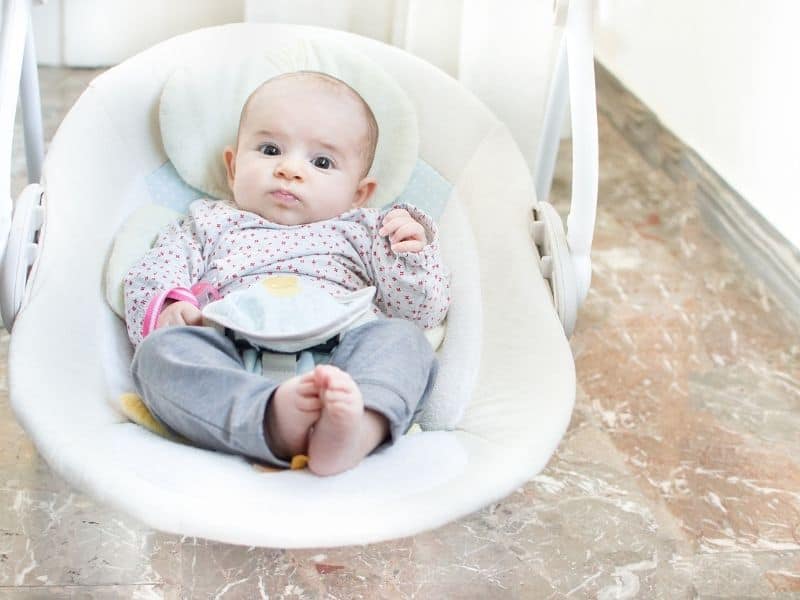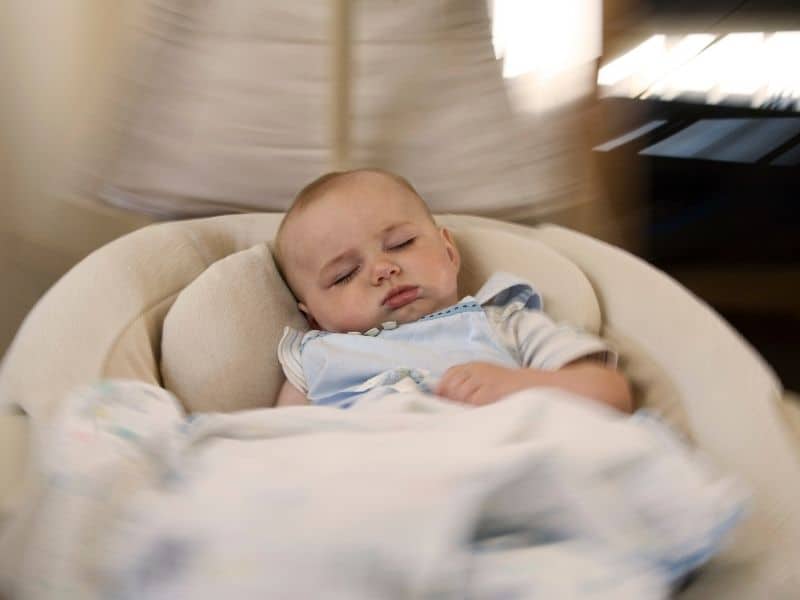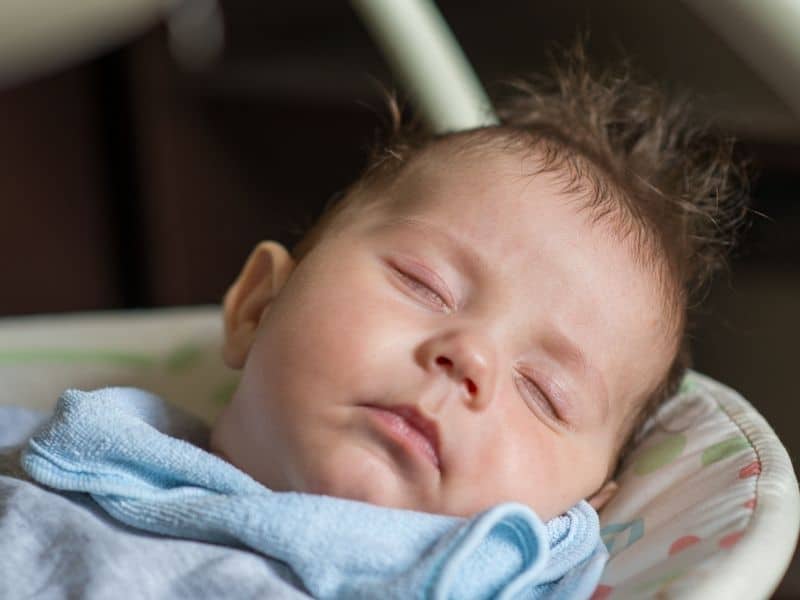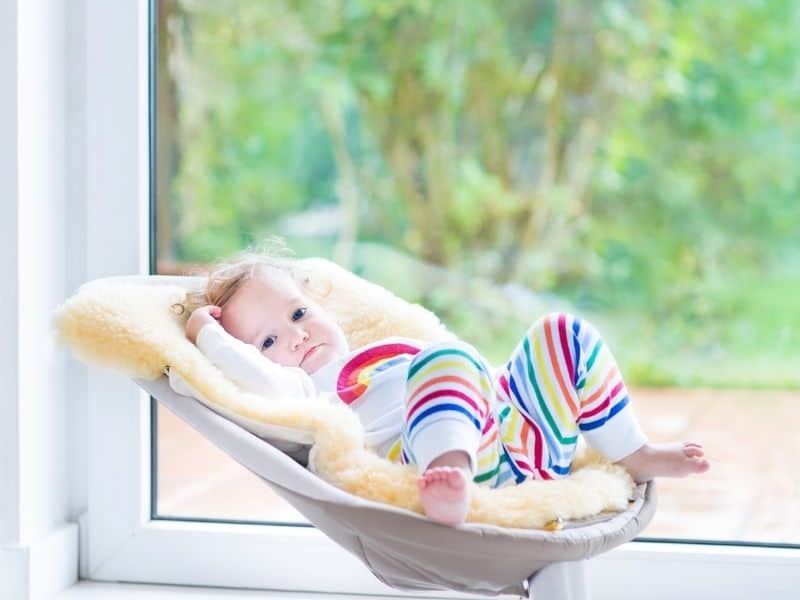Despite what you might expect, there’s no simple answer to this question – so take your time with this. We certainly will – we’ll examine the topic thoroughly and answer all the questions you might have.

More importantly, we’ll look at questions you should be asking but probably aren’t.
The takeaway will be a well-rounded understanding of all things swing safety. Let’s get to it.
What are the experts saying?
Most experts will tell you to limit the time your baby spends in a swing to one hour – preferably split into two chunks of no more than 30 minutes.
The #1 reason for limiting a baby’s time in a motorized swing is that it doesn’t help with the much-needed activity for proper development.
In other words, there are other more valuable things they could be doing in the time that would work towards connecting those developing neural pathways.
Two parts of the equation
The answer to properly using a swing is two-fold.
The first part is about using it to ensure your baby gets the activity they need for proper development.
The second, critical part, is making sure you’re not taking on extra risk because it’s convenient.
Let’s unpack that by addressing the latter first.
The research you need to know about
The AAP looked at close to 12K infant deaths that happened during sleep, and approximately 3% of them happened in swings and car seats – a total of 341 cases.
Most of those tragedies happened in car seats (219), closely followed by swings (122), with all other sitting gear (like bouncy chairs and seats) being far less risky.

Make a mental note of that. It will come in handy next time you think about leaving your little one to sleep in a swing or a car seat.
You can read more on the risk of sleeping in a swing here.
What it means for you
It means two things:
- You’ll need to take extra care when choosing the baby swing
- There are limits to using the swing, even if it’s the only thing that soothes the baby (which is the number one excuse for parents to leave the baby in for longer than necessary).
You’re tired, they’re fussy, and the only thing that calms them down is the rocking of the swing.
Trust me; I get it.
I’ve been there.
Follow the rules
Let’s take a concise approach and summarize all the APP swing safety guidelines in one simple bulleted list.
Summary of the AAP tips:
- The 4-month rule – a baby should only use a swing in the most reclined position
- The 1-hour rule – you should limit the time your baby spends in a swing to one hour per day
- The 30-minute rule – the total daily time should be split into two chunks of half an hour each
- Straps and angles – if the swing goes beyond a 50-degree angle, it should come with propper straps
- The stability rule – go with a sturdy swing that doesn’t fold easily
- Maximum weight rule – never exceed the weight limit of the swing
- The sturdy cradle rule – choose an infant swing with a cradle surface that’s reasonably flat and firm and doesn’t change shape when in motion
FAQs
Let’s address some of the questions that have been filling my inbox.
Can a newborn use a swing?
Yes, a newborn can safely use a swing as long as you follow the APP guidelines to keep the swing reclined as much as possible for the first four months.
“As much as possible” means choosing the most-reclined angle.
Why?
It’s because their tiny neck muscles are still developing and cannot support the weight of the head properly, which increases the risk of slouching.
To learn more, read my guide on when to stop using a baby swing.
Do baby swings cause brain damage?
No, they do not, given that you use them properly.
Based on emailing back and forth with people who ask me this, the reasons behind the question stem from “shaken baby syndrome.”
Otherwise known as SBS, this syndrome is a consequence of extreme cases of forcefully shaking the baby – to the point of causing brain swelling and damage.
We’ll touch on this again in a minute.
Is it bad for babies to swing too much?
The short answer to that would be yes; there is such a thing as overused baby swings. Limit their time in a swing to one hour per day.
Can a newborn sit in a swing?
The answer to that is, ”It depends on what you mean by ‘sit’”.
A newborn should only use the swing in the most reclined position for no more than one hour a day.
Other considerations
The answer to all questions about the safety of a baby swing relies on the assumptions that you’ve chosen well in the first place. So, let’s take a step back here and look at some of the crucial points of choosing a safe baby swing.
Styles and sizing
There’s a range of swings you can choose from – from those specifically designed for newborns to the adjustable models that will be with you for years to come. It’s the first thing you should check when looking to choose a good swing.
Importance of interaction
While leaving a fussy baby in a swing will give you the much-needed pause on those long days, there is such a thing as overdoing it.
The reasons go beyond safety
Not leaving your baby in a swing for too long is rooted in reasons that go far beyond safety and into the all-important interaction and attachment theory.
The attachment theory
First formulated by John Bowlby some odd 50 years ago, the attachment theory explores the importance of the interactions between a baby and a parent.

Bowlby’s hypothesis cuts to the very core of fighting off your instincts to leave your baby in a swing because they’re calmer in there. Bowlby’s theory suggests that interaction is crucial even when it’s harsh – and that’s what taking them out of the swing might feel like.
Attachment theory is not a green light to be harsh
Let’s take a moment here to make sure we’re not interpreting Bowlby’s words wrong.
What I said above doesn’t mean that you actually need to be harsh. Further down the line, harshness is associated with anxious and chaotic attachment patterns.
It only means that interaction takes precedence over just ‘leaving them be’ in the swing.
Used swings and hand-me-downs
If you’re getting a used one or hand-me-down, check if the model is safe and has never been recalled or implicated in cases of SIDS. A simple Google search will tell you all you need to know.
Go for a 5-point harness
Look for a 5-point harness – this is the official recommendation of the Consumer Product Safety Commission (CPSC). It goes towards keeping the baby in a safe position.
Never leave the swing unattended
Never leave the baby in a swing unsupervised – whatever you’re doing, move the swing so that you have a clear view of what’s going on inside.
It’s in the manual
Take your time to understand all the specifics of your swing as listed by the manufacturer in the user manual.
Split the difference
It’s best to limit one ‘session’ in the swing to 30 minutes and the total daily time to one hour.
A point of controversy – swings and SBS
Almost all SBS (Shaken Baby Syndrome) cases can be directly linked to a caregiver violently shaking the baby. There’s no evidence that swings and cradles are powerful enough to cause brain damage.
Room for speculation
There are cases of SBS that can’t be directly explained, and there are doctors out there who theorize that it might be caused by the abrupt stops and accelerations of sub-par cradles and swings.
To understand the dangers, let’s look at the science of the SBS.
Gray and white matter of the brain
The gray matter in the baby’s brain is significantly denser than the white matter, and the two respond differently to acceleration.
If the acceleration is substantial, this difference puts stress on the baby’s tiny blood vessels (veins of a newborn are thinner than 1mm) and can cause micro ruptures. It’s a kind of ‘whiplash’ effect if you will.

Over time, this can result in bleeding and brain damage.
Does this mean you should stay away from swings?
No, there’s no proof that well-made and tested swings pose a risk when used properly.
What it does mean, however, is that you can’t overemphasize the importance of following the rules and expert guidelines.
Final thoughts
Every year, we learn new things about baby safety, and adapting your parenting decisions to the new information is paramount.
One of those decisions is choosing a good baby swing and crafting a safe routine. Do both well, and a swing can be a life-saver.
Get it wrong, and you’re introducing unnecessary risk into the life of the gentle life that’s under your care.
Paul is a passionate dad who founded Upside Dad to share his parenting journey with other new parents. He graduated from Concordia University and worked as a test engineer for over a decade. Paul loves dad jokes and craft beer.
Learn more about Paul and Upside Dad here.
